
SenseVoice
Multilingual Voice Understanding Model
Stars: 1608
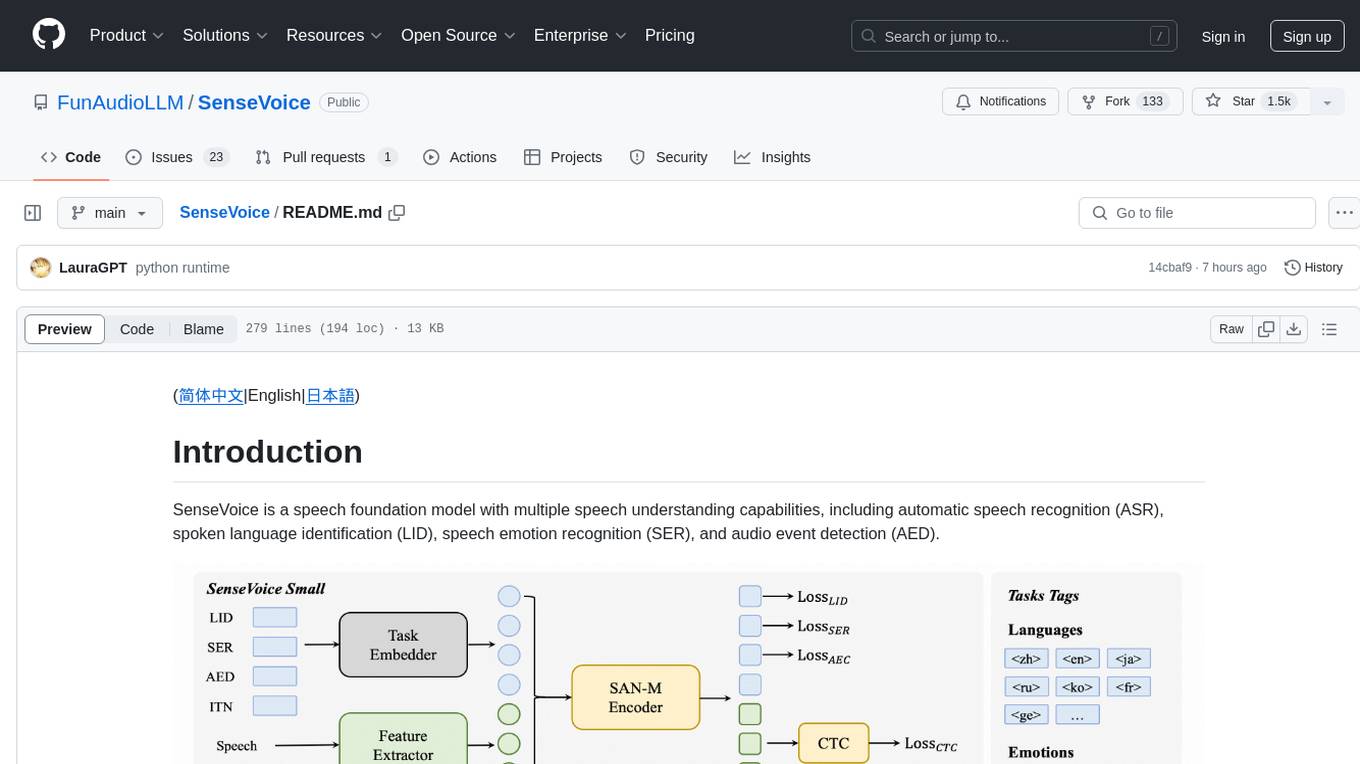
SenseVoice is a speech foundation model focusing on high-accuracy multilingual speech recognition, speech emotion recognition, and audio event detection. Trained with over 400,000 hours of data, it supports more than 50 languages and excels in emotion recognition and sound event detection. The model offers efficient inference with low latency and convenient finetuning scripts. It can be deployed for service with support for multiple client-side languages. SenseVoice-Small model is open-sourced and provides capabilities for Mandarin, Cantonese, English, Japanese, and Korean. The tool also includes features for natural speech generation and fundamental speech recognition tasks.
README:
SenseVoice is a speech foundation model with multiple speech understanding capabilities, including automatic speech recognition (ASR), spoken language identification (LID), speech emotion recognition (SER), and audio event detection (AED).
Homepage | What's News | Benchmarks | Install | Usage | Community
Model Zoo: modelscope, huggingface
Online Demo: modelscope demo, huggingface space
SenseVoice focuses on high-accuracy multilingual speech recognition, speech emotion recognition, and audio event detection.
- Multilingual Speech Recognition: Trained with over 400,000 hours of data, supporting more than 50 languages, the recognition performance surpasses that of the Whisper model.
-
Rich transcribe:
- Possess excellent emotion recognition capabilities, achieving and surpassing the effectiveness of the current best emotion recognition models on test data.
- Offer sound event detection capabilities, supporting the detection of various common human-computer interaction events such as bgm, applause, laughter, crying, coughing, and sneezing.
- Efficient Inference: The SenseVoice-Small model utilizes a non-autoregressive end-to-end framework, leading to exceptionally low inference latency. It requires only 70ms to process 10 seconds of audio, which is 15 times faster than Whisper-Large.
- Convenient Finetuning: Provide convenient finetuning scripts and strategies, allowing users to easily address long-tail sample issues according to their business scenarios.
- Service Deployment: Offer service deployment pipeline, supporting multi-concurrent requests, with client-side languages including Python, C++, HTML, Java, and C#, among others.
- 2024/7: Added Export Features for ONNX and libtorch, as well as Python Version Runtimes: funasr-onnx-0.4.0, funasr-torch-0.1.1
- 2024/7: The SenseVoice-Small voice understanding model is open-sourced, which offers high-precision multilingual speech recognition, emotion recognition, and audio event detection capabilities for Mandarin, Cantonese, English, Japanese, and Korean and leads to exceptionally low inference latency.
- 2024/7: The CosyVoice for natural speech generation with multi-language, timbre, and emotion control. CosyVoice excels in multi-lingual voice generation, zero-shot voice generation, cross-lingual voice cloning, and instruction-following capabilities. CosyVoice repo and CosyVoice space.
- 2024/7: FunASR is a fundamental speech recognition toolkit that offers a variety of features, including speech recognition (ASR), Voice Activity Detection (VAD), Punctuation Restoration, Language Models, Speaker Verification, Speaker Diarization and multi-talker ASR.
We compared the performance of multilingual speech recognition between SenseVoice and Whisper on open-source benchmark datasets, including AISHELL-1, AISHELL-2, Wenetspeech, LibriSpeech, and Common Voice. In terms of Chinese and Cantonese recognition, the SenseVoice-Small model has advantages.
Due to the current lack of widely-used benchmarks and methods for speech emotion recognition, we conducted evaluations across various metrics on multiple test sets and performed a comprehensive comparison with numerous results from recent benchmarks. The selected test sets encompass data in both Chinese and English, and include multiple styles such as performances, films, and natural conversations. Without finetuning on the target data, SenseVoice was able to achieve and exceed the performance of the current best speech emotion recognition models.
Furthermore, we compared multiple open-source speech emotion recognition models on the test sets, and the results indicate that the SenseVoice-Large model achieved the best performance on nearly all datasets, while the SenseVoice-Small model also surpassed other open-source models on the majority of the datasets.
Although trained exclusively on speech data, SenseVoice can still function as a standalone event detection model. We compared its performance on the environmental sound classification ESC-50 dataset against the widely used industry models BEATS and PANN. The SenseVoice model achieved commendable results on these tasks. However, due to limitations in training data and methodology, its event classification performance has some gaps compared to specialized AED models.
The SenseVoice-Small model deploys a non-autoregressive end-to-end architecture, resulting in extremely low inference latency. With a similar number of parameters to the Whisper-Small model, it infers more than 5 times faster than Whisper-Small and 15 times faster than Whisper-Large.
pip install -r requirements.txtSupports input of audio in any format and of any duration.
from funasr import AutoModel
from funasr.utils.postprocess_utils import rich_transcription_postprocess
model_dir = "iic/SenseVoiceSmall"
model = AutoModel(
model=model_dir,
trust_remote_code=True,
remote_code="./model.py",
vad_model="fsmn-vad",
vad_kwargs={"max_single_segment_time": 30000},
device="cuda:0",
)
# en
res = model.generate(
input=f"{model.model_path}/example/en.mp3",
cache={},
language="auto", # "zh", "en", "yue", "ja", "ko", "nospeech"
use_itn=True,
batch_size_s=60,
merge_vad=True, #
merge_length_s=15,
)
text = rich_transcription_postprocess(res[0]["text"])
print(text)Parameter Description (Click to Expand)
-
model_dir: The name of the model, or the path to the model on the local disk. -
trust_remote_code:- When
True, it means that the model's code implementation is loaded fromremote_code, which specifies the exact location of themodelcode (for example,model.pyin the current directory). It supports absolute paths, relative paths, and network URLs. - When
False, it indicates that the model's code implementation is the integrated version within FunASR. At this time, modifications made tomodel.pyin the current directory will not be effective, as the version loaded is the internal one from FunASR. For the model code, click here to view.
- When
-
vad_model: This indicates the activation of VAD (Voice Activity Detection). The purpose of VAD is to split long audio into shorter clips. In this case, the inference time includes both VAD and SenseVoice total consumption, and represents the end-to-end latency. If you wish to test the SenseVoice model's inference time separately, the VAD model can be disabled. -
vad_kwargs: Specifies the configurations for the VAD model.max_single_segment_time: denotes the maximum duration for audio segmentation by thevad_model, with the unit being milliseconds (ms). -
use_itn: Whether the output result includes punctuation and inverse text normalization. -
batch_size_s: Indicates the use of dynamic batching, where the total duration of audio in the batch is measured in seconds (s). -
merge_vad: Whether to merge short audio fragments segmented by the VAD model, with the merged length beingmerge_length_s, in seconds (s). -
ban_emo_unk: Whether to ban the output of theemo_unktoken.
If all inputs are short audios (<30s), and batch inference is needed to speed up inference efficiency, the VAD model can be removed, and batch_size can be set accordingly.
model = AutoModel(model=model_dir, trust_remote_code=True, device="cuda:0")
res = model.generate(
input=f"{model.model_path}/example/en.mp3",
cache={},
language="zh", # "zh", "en", "yue", "ja", "ko", "nospeech"
use_itn=False,
batch_size=64,
)For more usage, please refer to docs
Supports input of audio in any format, with an input duration limit of 30 seconds or less.
from model import SenseVoiceSmall
from funasr.utils.postprocess_utils import rich_transcription_postprocess
model_dir = "iic/SenseVoiceSmall"
m, kwargs = SenseVoiceSmall.from_pretrained(model=model_dir, device="cuda:0")
m.eval()
res = m.inference(
data_in=f"{kwargs['model_path']}/example/en.mp3",
language="auto", # "zh", "en", "yue", "ja", "ko", "nospeech"
use_itn=False,
ban_emo_unk=False,
**kwargs,
)
text = rich_transcription_postprocess(res[0][0]["text"])
print(text)ONNX and Libtorch Export
# pip3 install -U funasr funasr-onnx
from pathlib import Path
from funasr_onnx import SenseVoiceSmall
from funasr_onnx.utils.postprocess_utils import rich_transcription_postprocess
model_dir = "iic/SenseVoiceSmall"
model = SenseVoiceSmall(model_dir, batch_size=10, quantize=True)
# inference
wav_or_scp = ["{}/.cache/modelscope/hub/{}/example/en.mp3".format(Path.home(), model_dir)]
res = model(wav_or_scp, language="auto", use_itn=True)
print([rich_transcription_postprocess(i) for i in res])Note: ONNX model is exported to the original model directory.
from pathlib import Path
from funasr_torch import SenseVoiceSmall
from funasr_torch.utils.postprocess_utils import rich_transcription_postprocess
model_dir = "iic/SenseVoiceSmall"
model = SenseVoiceSmall(model_dir, batch_size=10, device="cuda:0")
wav_or_scp = ["{}/.cache/modelscope/hub/{}/example/en.mp3".format(Path.home(), model_dir)]
res = model(wav_or_scp, language="auto", use_itn=True)
print([rich_transcription_postprocess(i) for i in res])Note: Libtorch model is exported to the original model directory.
export SENSEVOICE_DEVICE=cuda:0
fastapi run --port 50000git clone https://github.com/alibaba/FunASR.git && cd FunASR
pip3 install -e ./Data examples
{"key": "YOU0000008470_S0000238_punc_itn", "text_language": "<|en|>", "emo_target": "<|NEUTRAL|>", "event_target": "<|Speech|>", "with_or_wo_itn": "<|withitn|>", "target": "Including legal due diligence, subscription agreement, negotiation.", "source": "/cpfs01/shared/Group-speech/beinian.lzr/data/industrial_data/english_all/audio/YOU0000008470_S0000238.wav", "target_len": 7, "source_len": 140}
{"key": "AUD0000001556_S0007580", "text_language": "<|en|>", "emo_target": "<|NEUTRAL|>", "event_target": "<|Speech|>", "with_or_wo_itn": "<|woitn|>", "target": "there is a tendency to identify the self or take interest in what one has got used to", "source": "/cpfs01/shared/Group-speech/beinian.lzr/data/industrial_data/english_all/audio/AUD0000001556_S0007580.wav", "target_len": 18, "source_len": 360}
Full ref to data/train_example.jsonl
Data Prepare Details
Description:
-
key: audio file unique ID -
source:path to the audio file -
source_len:number of fbank frames of the audio file -
target:transcription -
target_len:length of target -
text_language:language id of the audio file -
emo_target:emotion label of the audio file -
event_target:event label of the audio file -
with_or_wo_itn:whether includes punctuation and inverse text normalization
train_text.txt
BAC009S0764W0121 甚至出现交易几乎停滞的情况
BAC009S0916W0489 湖北一公司以员工名义贷款数十员工负债千万
asr_example_cn_en 所有只要处理 data 不管你是做 machine learning 做 deep learning 做 data analytics 做 data science 也好 scientist 也好通通都要都做的基本功啊那 again 先先对有一些>也许对
ID0012W0014 he tried to think how it could betrain_wav.scp
BAC009S0764W0121 https://isv-data.oss-cn-hangzhou.aliyuncs.com/ics/MaaS/ASR/test_audio/BAC009S0764W0121.wav
BAC009S0916W0489 https://isv-data.oss-cn-hangzhou.aliyuncs.com/ics/MaaS/ASR/test_audio/BAC009S0916W0489.wav
asr_example_cn_en https://isv-data.oss-cn-hangzhou.aliyuncs.com/ics/MaaS/ASR/test_audio/asr_example_cn_en.wav
ID0012W0014 https://isv-data.oss-cn-hangzhou.aliyuncs.com/ics/MaaS/ASR/test_audio/asr_example_en.wavtrain_text_language.txt
The language ids include <|zh|>、<|en|>、<|yue|>、<|ja|> and <|ko|>.
BAC009S0764W0121 <|zh|>
BAC009S0916W0489 <|zh|>
asr_example_cn_en <|zh|>
ID0012W0014 <|en|>train_emo.txt
The emotion labels include<|HAPPY|>、<|SAD|>、<|ANGRY|>、<|NEUTRAL|>、<|FEARFUL|>、<|DISGUSTED|> and <|SURPRISED|>.
BAC009S0764W0121 <|NEUTRAL|>
BAC009S0916W0489 <|NEUTRAL|>
asr_example_cn_en <|NEUTRAL|>
ID0012W0014 <|NEUTRAL|>train_event.txt
The event labels include<|BGM|>、<|Speech|>、<|Applause|>、<|Laughter|>、<|Cry|>、<|Sneeze|>、<|Breath|> and <|Cough|>.
BAC009S0764W0121 <|Speech|>
BAC009S0916W0489 <|Speech|>
asr_example_cn_en <|Speech|>
ID0012W0014 <|Speech|>Command
# generate train.jsonl and val.jsonl from wav.scp, text.txt, text_language.txt, emo_target.txt, event_target.txt
sensevoice2jsonl \
++scp_file_list='["../../../data/list/train_wav.scp", "../../../data/list/train_text.txt", "../../../data/list/train_text_language.txt", "../../../data/list/train_emo.txt", "../../../data/list/train_event.txt"]' \
++data_type_list='["source", "target", "text_language", "emo_target", "event_target"]' \
++jsonl_file_out="../../../data/list/train.jsonl"If there is no train_text_language.txt, train_emo_target.txt and train_event_target.txt, the language, emotion and event label will be predicted automatically by using the SenseVoice model.
# generate train.jsonl and val.jsonl from wav.scp and text.txt
sensevoice2jsonl \
++scp_file_list='["../../../data/list/train_wav.scp", "../../../data/list/train_text.txt"]' \
++data_type_list='["source", "target"]' \
++jsonl_file_out="../../../data/list/train.jsonl" \
++model_dir='iic/SenseVoiceSmall'Ensure to modify the train_tool in finetune.sh to the absolute path of funasr/bin/train_ds.py from the FunASR installation directory you have set up earlier.
bash finetune.shpython webui.py- Triton (GPU) Deployment Best Practices: Using Triton + TensorRT, tested with FP32, achieving an acceleration ratio of 526 on V100 GPU. FP16 support is in progress. Repository
- Sherpa-onnx Deployment Best Practices: Supports using SenseVoice in 10 programming languages: C++, C, Python, C#, Go, Swift, Kotlin, Java, JavaScript, and Dart. Also supports deploying SenseVoice on platforms like iOS, Android, and Raspberry Pi. Repository
If you encounter problems in use, you can directly raise Issues on the github page.
You can also scan the following DingTalk group QR code to join the community group for communication and discussion.
| FunAudioLLM | FunASR |
|---|---|
 |
For Tasks:
Click tags to check more tools for each tasksFor Jobs:
Alternative AI tools for SenseVoice
Similar Open Source Tools

SenseVoice
SenseVoice is a speech foundation model focusing on high-accuracy multilingual speech recognition, speech emotion recognition, and audio event detection. Trained with over 400,000 hours of data, it supports more than 50 languages and excels in emotion recognition and sound event detection. The model offers efficient inference with low latency and convenient finetuning scripts. It can be deployed for service with support for multiple client-side languages. SenseVoice-Small model is open-sourced and provides capabilities for Mandarin, Cantonese, English, Japanese, and Korean. The tool also includes features for natural speech generation and fundamental speech recognition tasks.
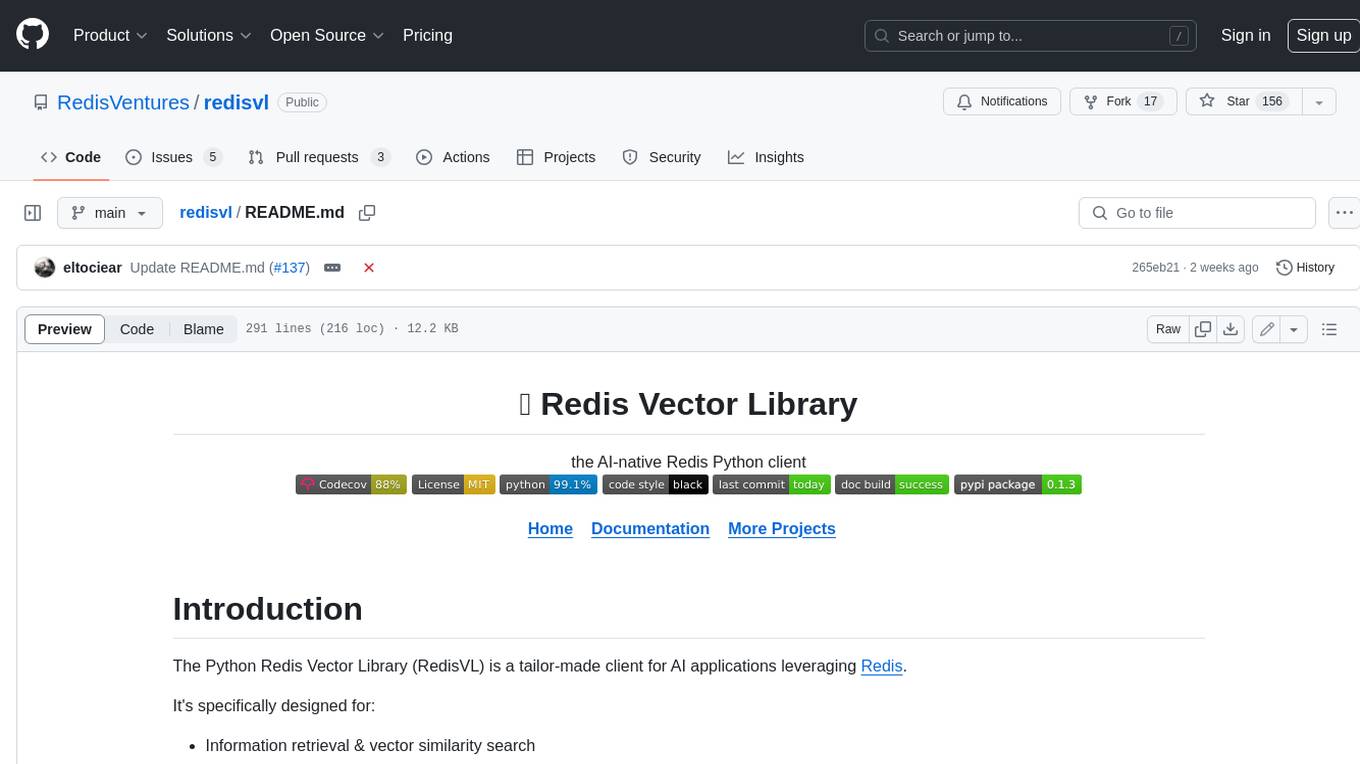
redisvl
Redis Vector Library (RedisVL) is a Python client library for building AI applications on top of Redis. It provides a high-level interface for managing vector indexes, performing vector search, and integrating with popular embedding models and providers. RedisVL is designed to make it easy for developers to build and deploy AI applications that leverage the speed, flexibility, and reliability of Redis.
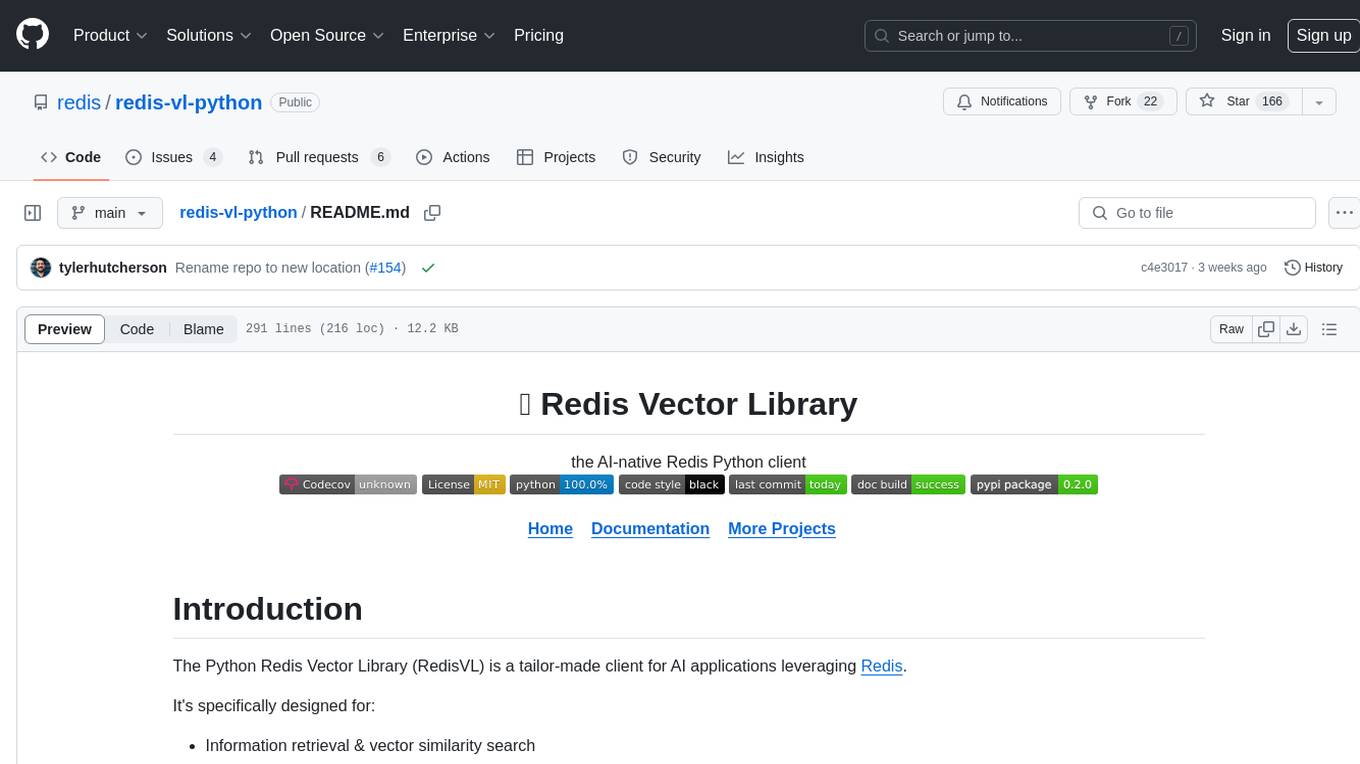
redis-vl-python
The Python Redis Vector Library (RedisVL) is a tailor-made client for AI applications leveraging Redis. It enhances applications with Redis' speed, flexibility, and reliability, incorporating capabilities like vector-based semantic search, full-text search, and geo-spatial search. The library bridges the gap between the emerging AI-native developer ecosystem and the capabilities of Redis by providing a lightweight, elegant, and intuitive interface. It abstracts the features of Redis into a grammar that is more aligned to the needs of today's AI/ML Engineers or Data Scientists.
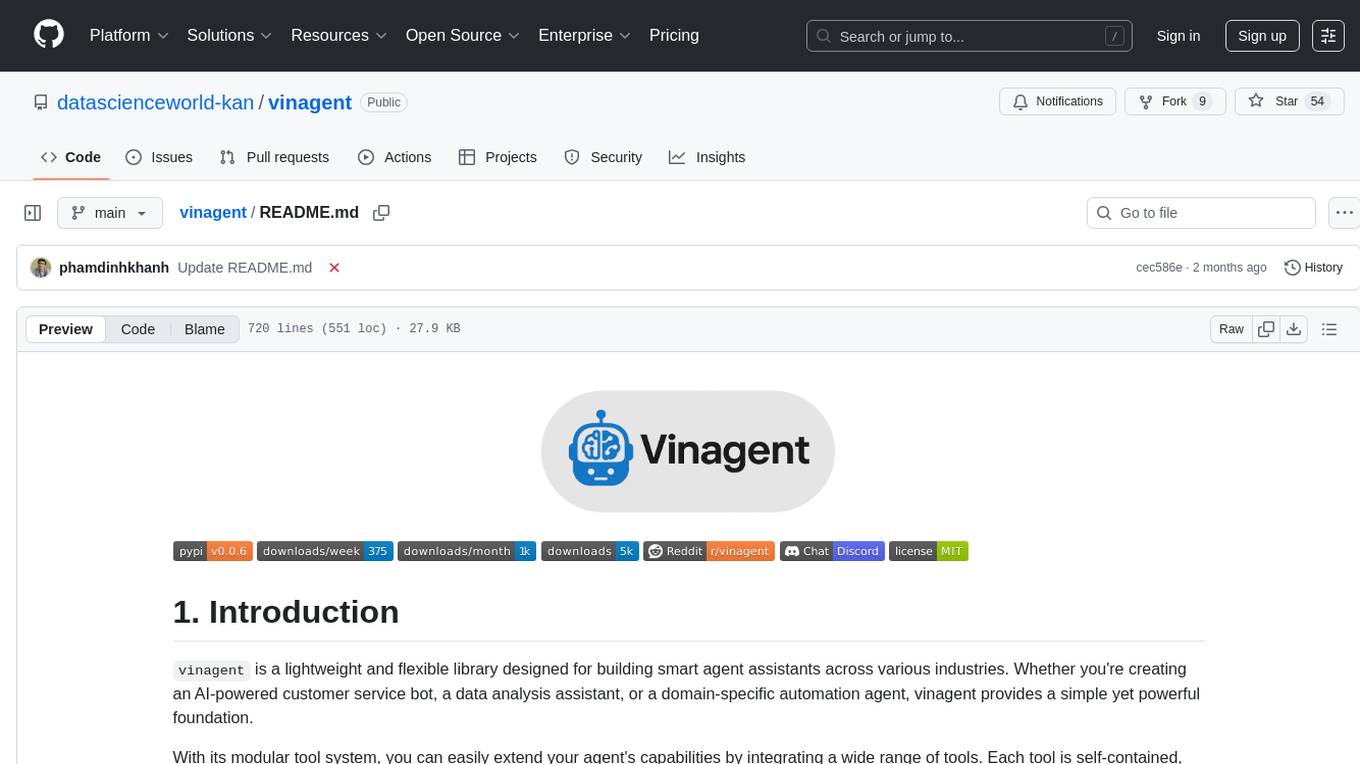
vinagent
Vinagent is a lightweight and flexible library designed for building smart agent assistants across various industries. It provides a simple yet powerful foundation for creating AI-powered customer service bots, data analysis assistants, or domain-specific automation agents. With its modular tool system, users can easily extend their agent's capabilities by integrating a wide range of tools that are self-contained, well-documented, and can be registered dynamically. Vinagent allows users to scale and adapt their agents to new tasks or environments effortlessly.
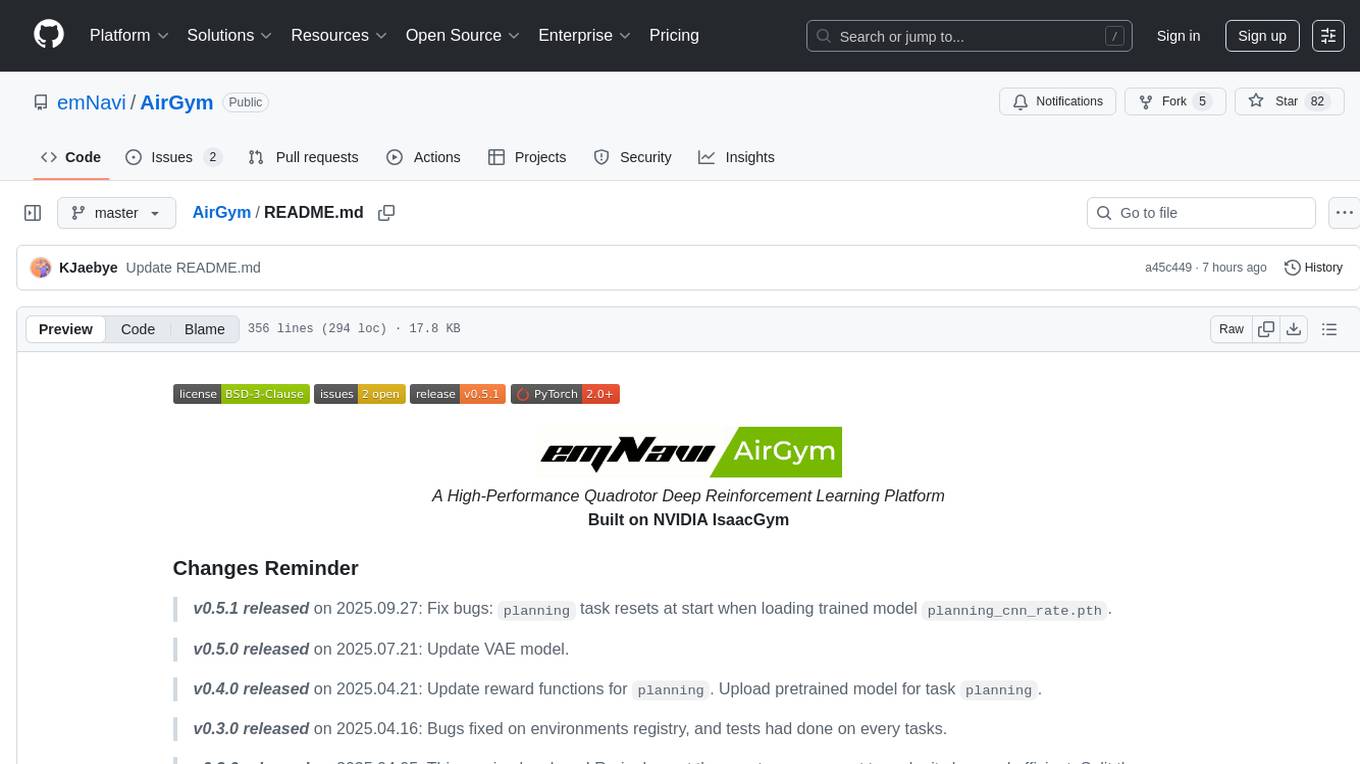
AirGym
AirGym is an open source Python quadrotor simulator based on IsaacGym, providing a high-fidelity dynamics and Deep Reinforcement Learning (DRL) framework for quadrotor robot learning research. It offers a lightweight and customizable platform with strict alignment with PX4 logic, multiple control modes, and Sim-to-Real toolkits. Users can perform tasks such as Hovering, Balloon, Tracking, Avoid, and Planning, with the ability to create customized environments and tasks. The tool also supports training from scratch, visual encoding approaches, playing and testing of trained models, and customization of new tasks and assets.
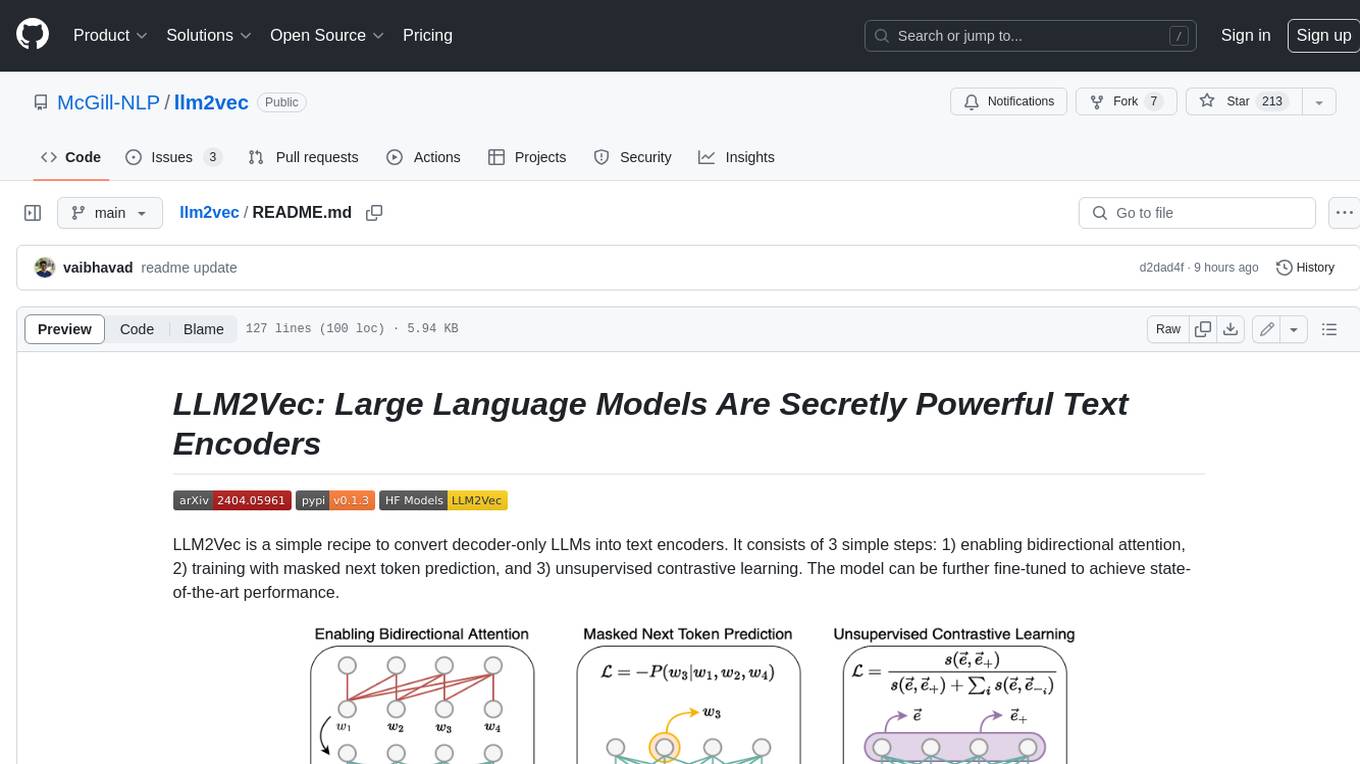
llm2vec
LLM2Vec is a simple recipe to convert decoder-only LLMs into text encoders. It consists of 3 simple steps: 1) enabling bidirectional attention, 2) training with masked next token prediction, and 3) unsupervised contrastive learning. The model can be further fine-tuned to achieve state-of-the-art performance.
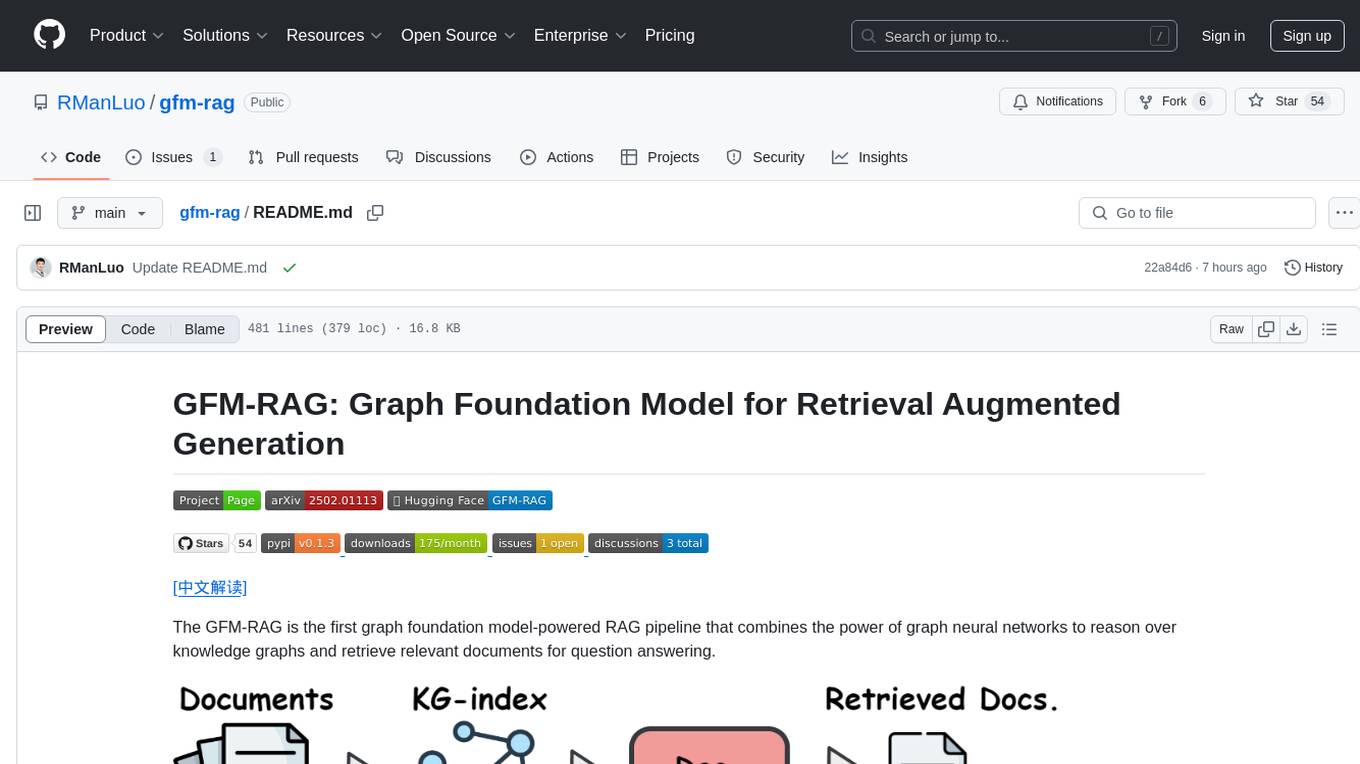
gfm-rag
The GFM-RAG is a graph foundation model-powered pipeline that combines graph neural networks to reason over knowledge graphs and retrieve relevant documents for question answering. It features a knowledge graph index, efficiency in multi-hop reasoning, generalizability to unseen datasets, transferability for fine-tuning, compatibility with agent-based frameworks, and interpretability of reasoning paths. The tool can be used for conducting retrieval and question answering tasks using pre-trained models or fine-tuning on custom datasets.
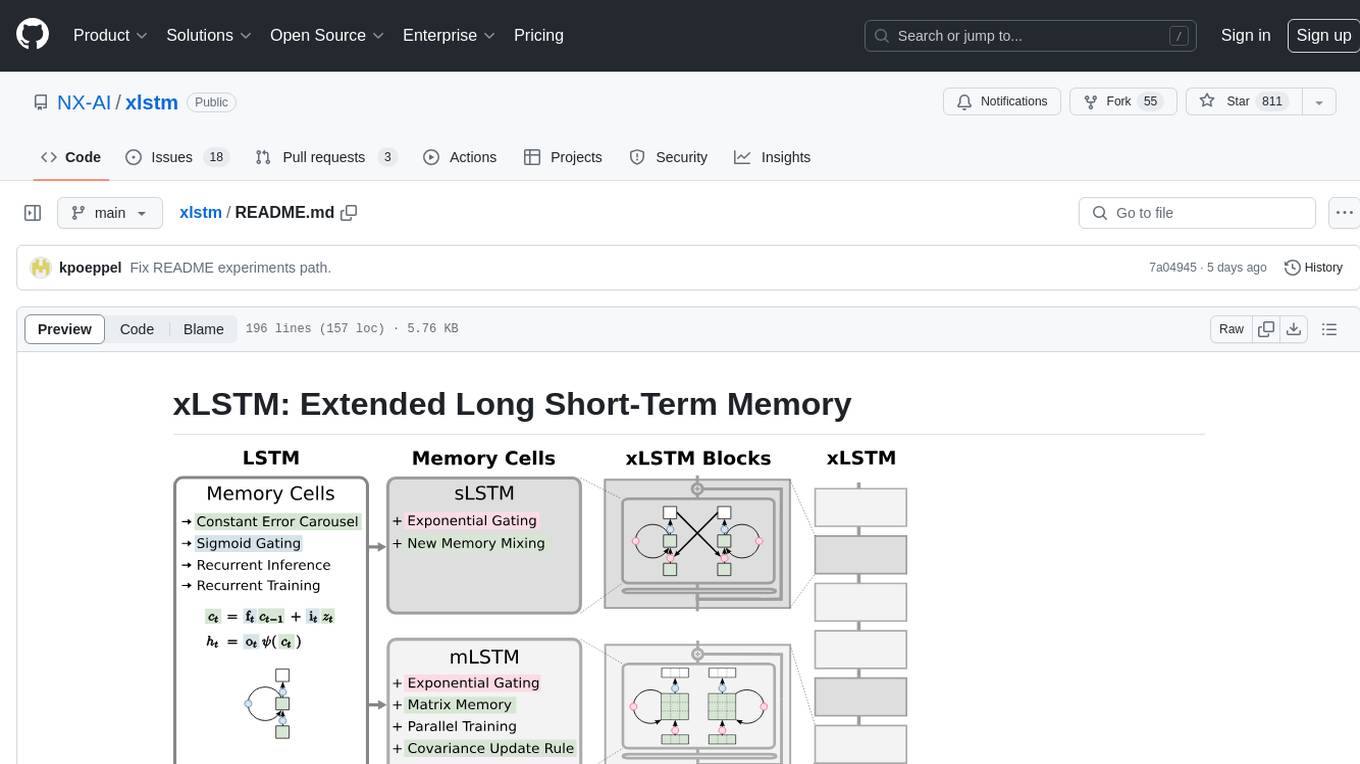
xlstm
xLSTM is a new Recurrent Neural Network architecture based on ideas of the original LSTM. Through Exponential Gating with appropriate normalization and stabilization techniques and a new Matrix Memory it overcomes the limitations of the original LSTM and shows promising performance on Language Modeling when compared to Transformers or State Space Models. The package is based on PyTorch and was tested for versions >=1.8. For the CUDA version of xLSTM, you need Compute Capability >= 8.0. The xLSTM tool provides two main components: xLSTMBlockStack for non-language applications or integrating in other architectures, and xLSTMLMModel for language modeling or other token-based applications.
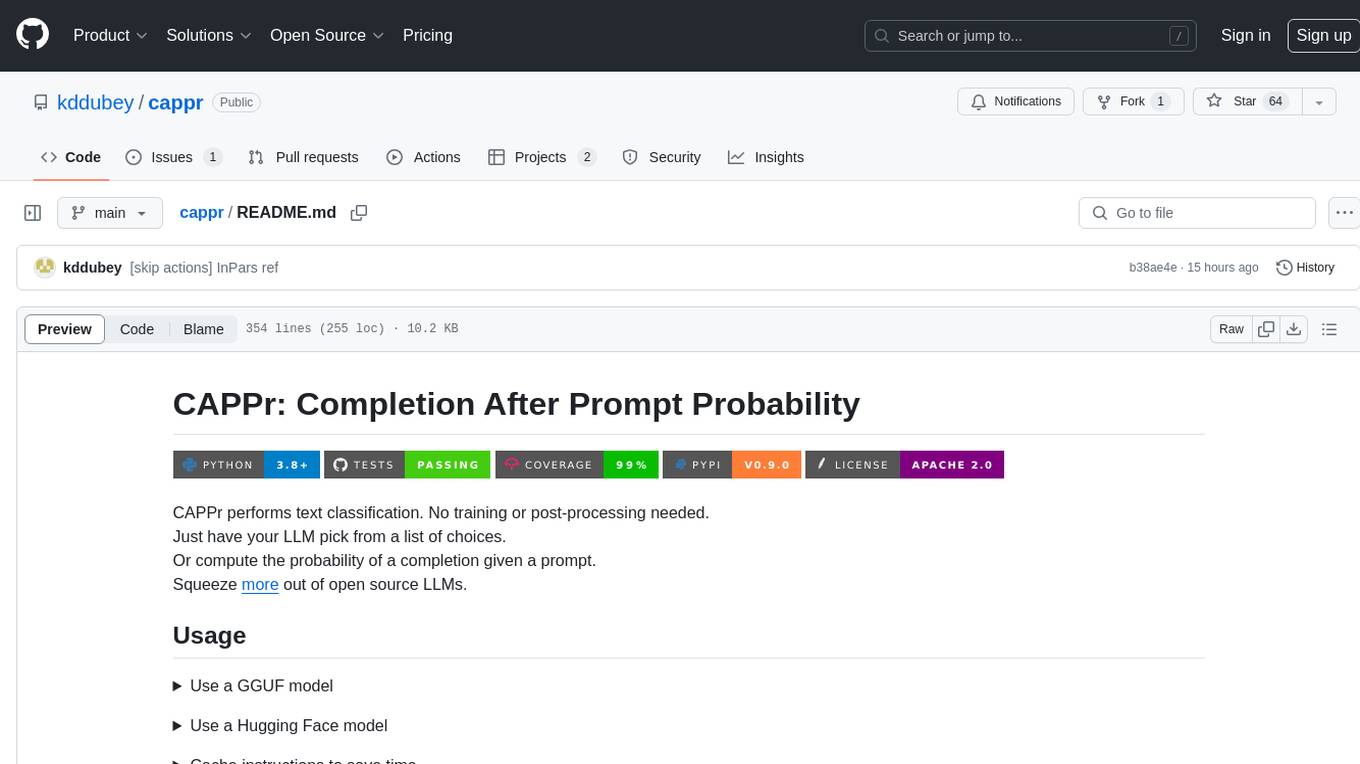
cappr
CAPPr is a tool for text classification that does not require training or post-processing. It allows users to have their language models pick from a list of choices or compute the probability of a completion given a prompt. The tool aims to help users get more out of open source language models by simplifying the text classification process. CAPPr can be used with GGUF models, Hugging Face models, models from the OpenAI API, and for tasks like caching instructions, extracting final answers from step-by-step completions, and running predictions in batches with different sets of completions.
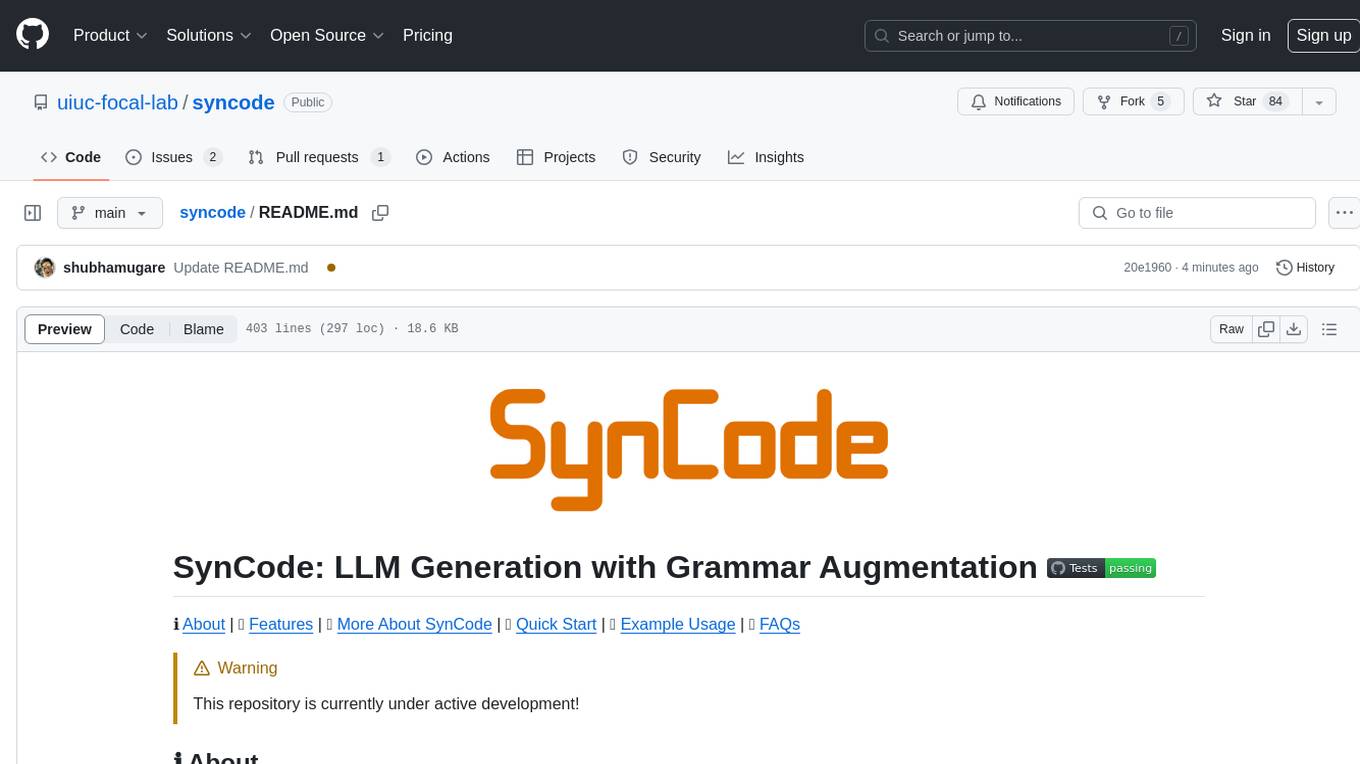
syncode
SynCode is a novel framework for the grammar-guided generation of Large Language Models (LLMs) that ensures syntactically valid output with respect to defined Context-Free Grammar (CFG) rules. It supports general-purpose programming languages like Python, Go, SQL, JSON, and more, allowing users to define custom grammars using EBNF syntax. The tool compares favorably to other constrained decoders and offers features like fast grammar-guided generation, compatibility with HuggingFace Language Models, and the ability to work with various decoding strategies.
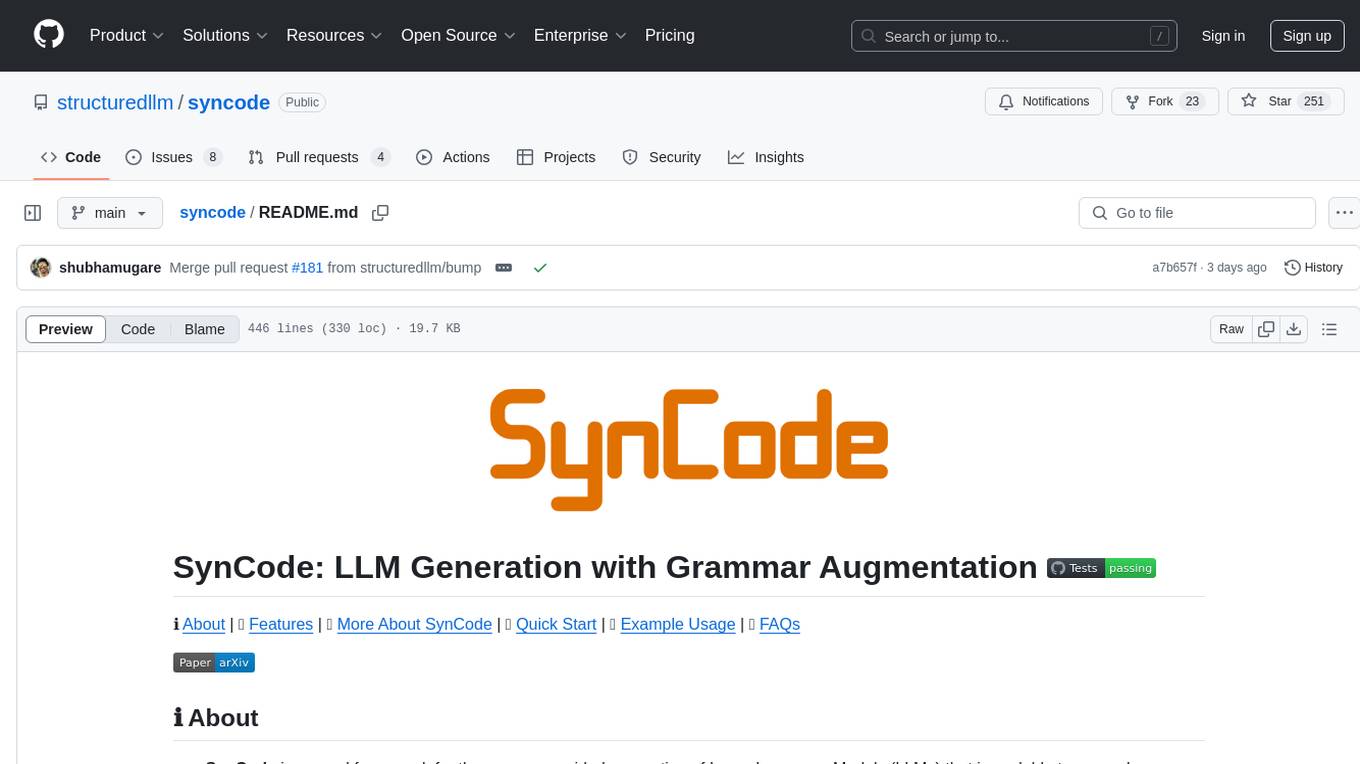
syncode
SynCode is a novel framework for the grammar-guided generation of Large Language Models (LLMs) that ensures syntactically valid output based on a Context-Free Grammar (CFG). It supports various programming languages like Python, Go, SQL, Math, JSON, and more. Users can define custom grammars using EBNF syntax. SynCode offers fast generation, seamless integration with HuggingFace Language Models, and the ability to sample with different decoding strategies.
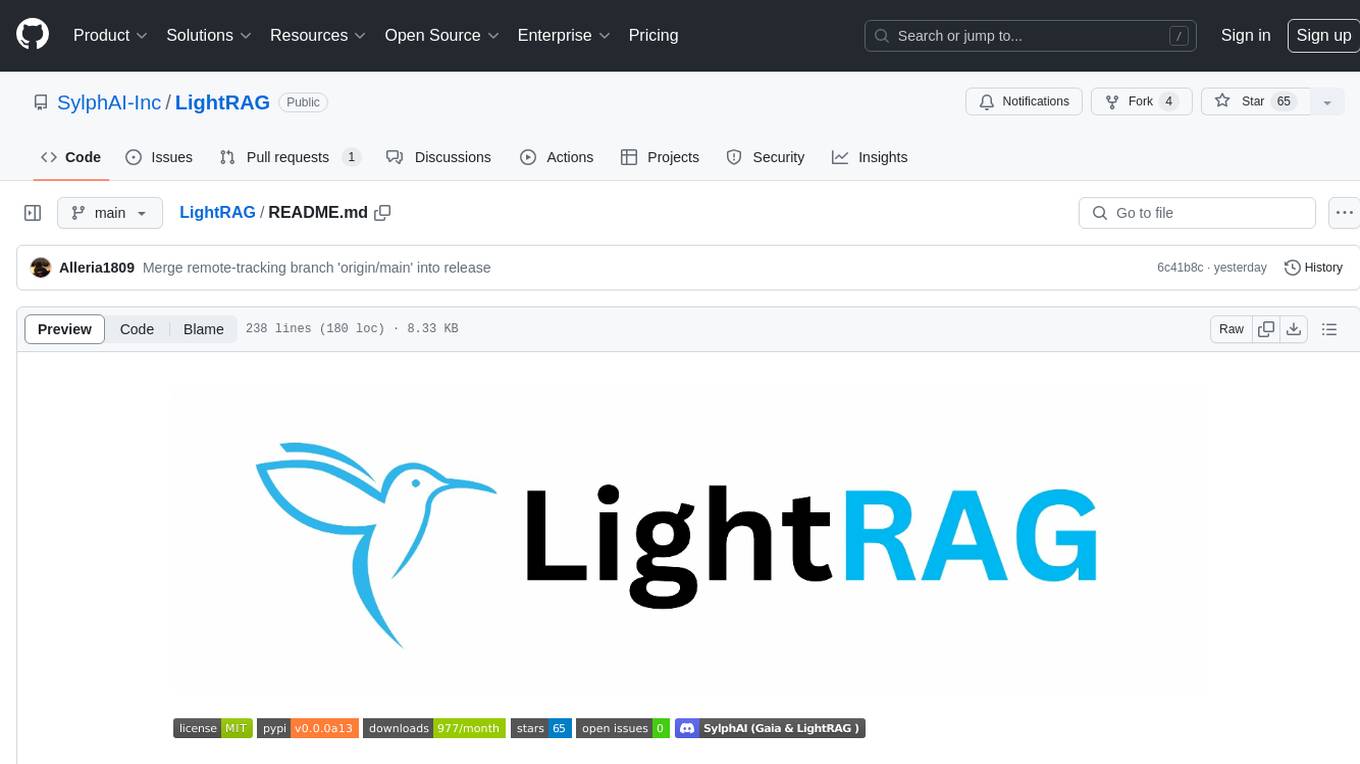
LightRAG
LightRAG is a PyTorch library designed for building and optimizing Retriever-Agent-Generator (RAG) pipelines. It follows principles of simplicity, quality, and optimization, offering developers maximum customizability with minimal abstraction. The library includes components for model interaction, output parsing, and structured data generation. LightRAG facilitates tasks like providing explanations and examples for concepts through a question-answering pipeline.
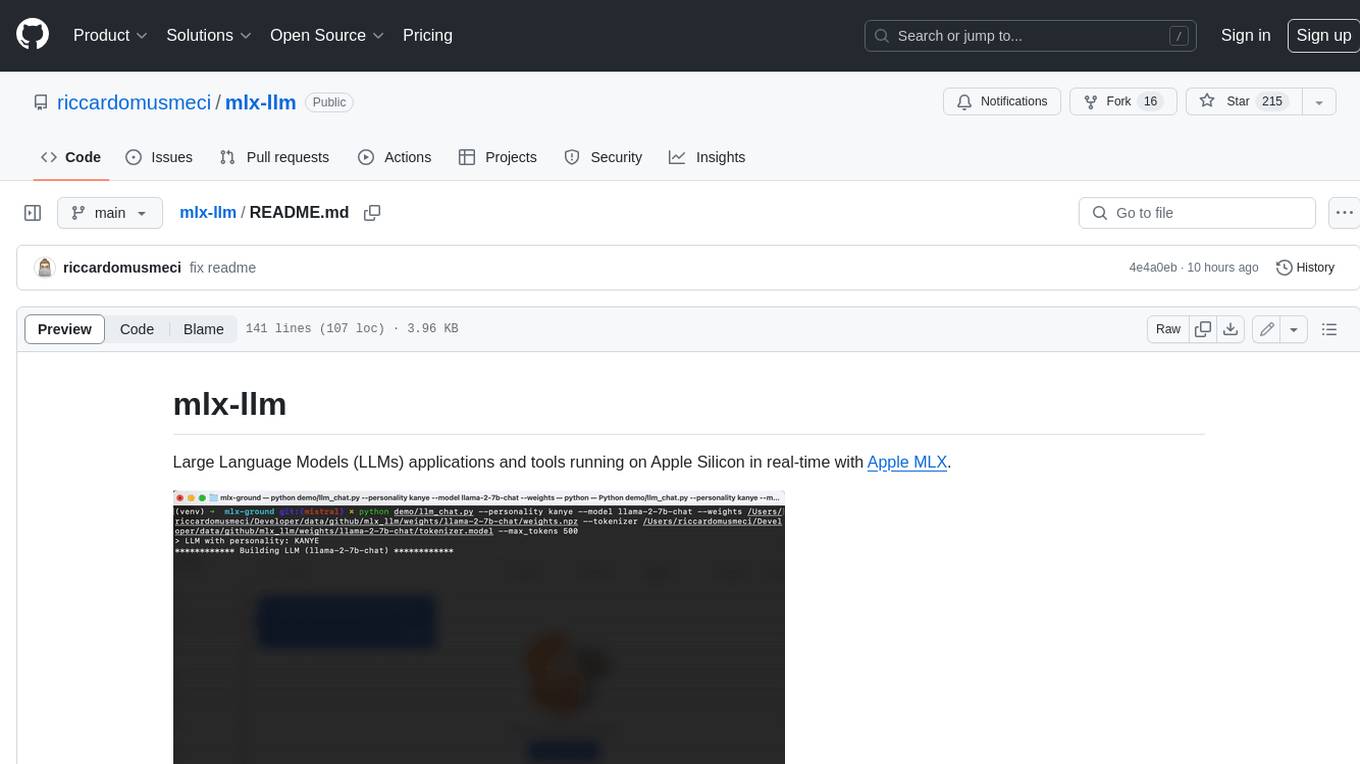
mlx-llm
mlx-llm is a library that allows you to run Large Language Models (LLMs) on Apple Silicon devices in real-time using Apple's MLX framework. It provides a simple and easy-to-use API for creating, loading, and using LLM models, as well as a variety of applications such as chatbots, fine-tuning, and retrieval-augmented generation.
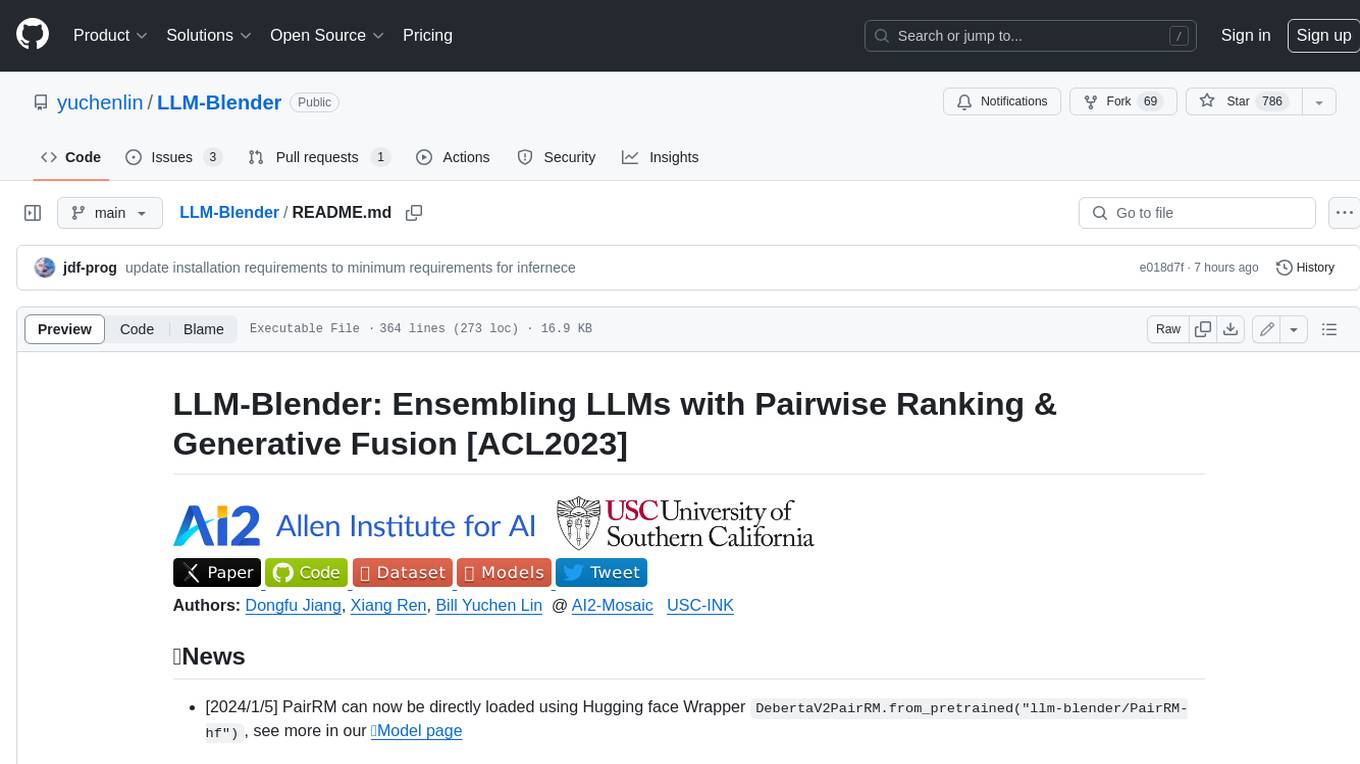
LLM-Blender
LLM-Blender is a framework for ensembling large language models (LLMs) to achieve superior performance. It consists of two modules: PairRanker and GenFuser. PairRanker uses pairwise comparisons to distinguish between candidate outputs, while GenFuser merges the top-ranked candidates to create an improved output. LLM-Blender has been shown to significantly surpass the best LLMs and baseline ensembling methods across various metrics on the MixInstruct benchmark dataset.
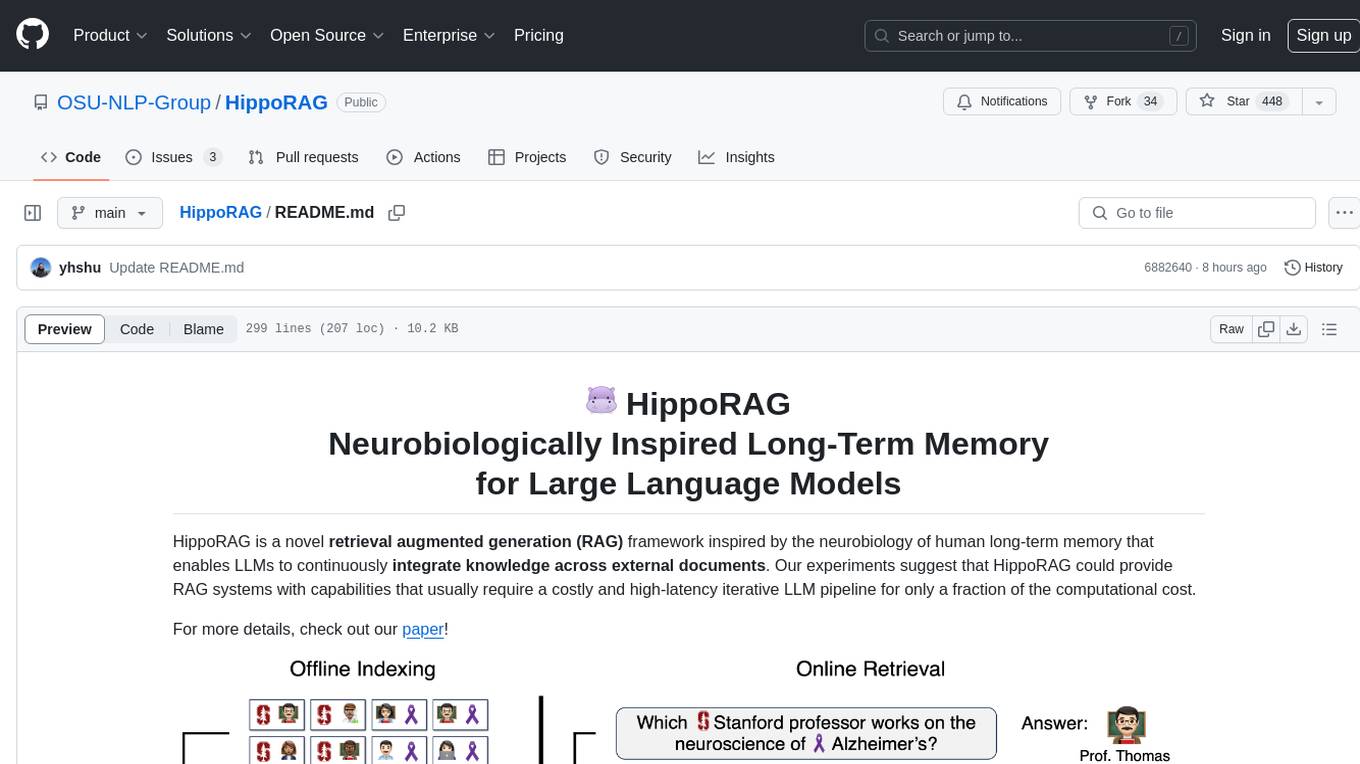
HippoRAG
HippoRAG is a novel retrieval augmented generation (RAG) framework inspired by the neurobiology of human long-term memory that enables Large Language Models (LLMs) to continuously integrate knowledge across external documents. It provides RAG systems with capabilities that usually require a costly and high-latency iterative LLM pipeline for only a fraction of the computational cost. The tool facilitates setting up retrieval corpus, indexing, and retrieval processes for LLMs, offering flexibility in choosing different online LLM APIs or offline LLM deployments through LangChain integration. Users can run retrieval on pre-defined queries or integrate directly with the HippoRAG API. The tool also supports reproducibility of experiments and provides data, baselines, and hyperparameter tuning scripts for research purposes.

req_llm
ReqLLM is a Req-based library for LLM interactions, offering a unified interface to AI providers through a plugin-based architecture. It brings composability and middleware advantages to LLM interactions, with features like auto-synced providers/models, typed data structures, ergonomic helpers, streaming capabilities, usage & cost extraction, and a plugin-based provider system. Users can easily generate text, structured data, embeddings, and track usage costs. The tool supports various AI providers like Anthropic, OpenAI, Groq, Google, and xAI, and allows for easy addition of new providers. ReqLLM also provides API key management, detailed documentation, and a roadmap for future enhancements.
For similar tasks

SenseVoice
SenseVoice is a speech foundation model focusing on high-accuracy multilingual speech recognition, speech emotion recognition, and audio event detection. Trained with over 400,000 hours of data, it supports more than 50 languages and excels in emotion recognition and sound event detection. The model offers efficient inference with low latency and convenient finetuning scripts. It can be deployed for service with support for multiple client-side languages. SenseVoice-Small model is open-sourced and provides capabilities for Mandarin, Cantonese, English, Japanese, and Korean. The tool also includes features for natural speech generation and fundamental speech recognition tasks.
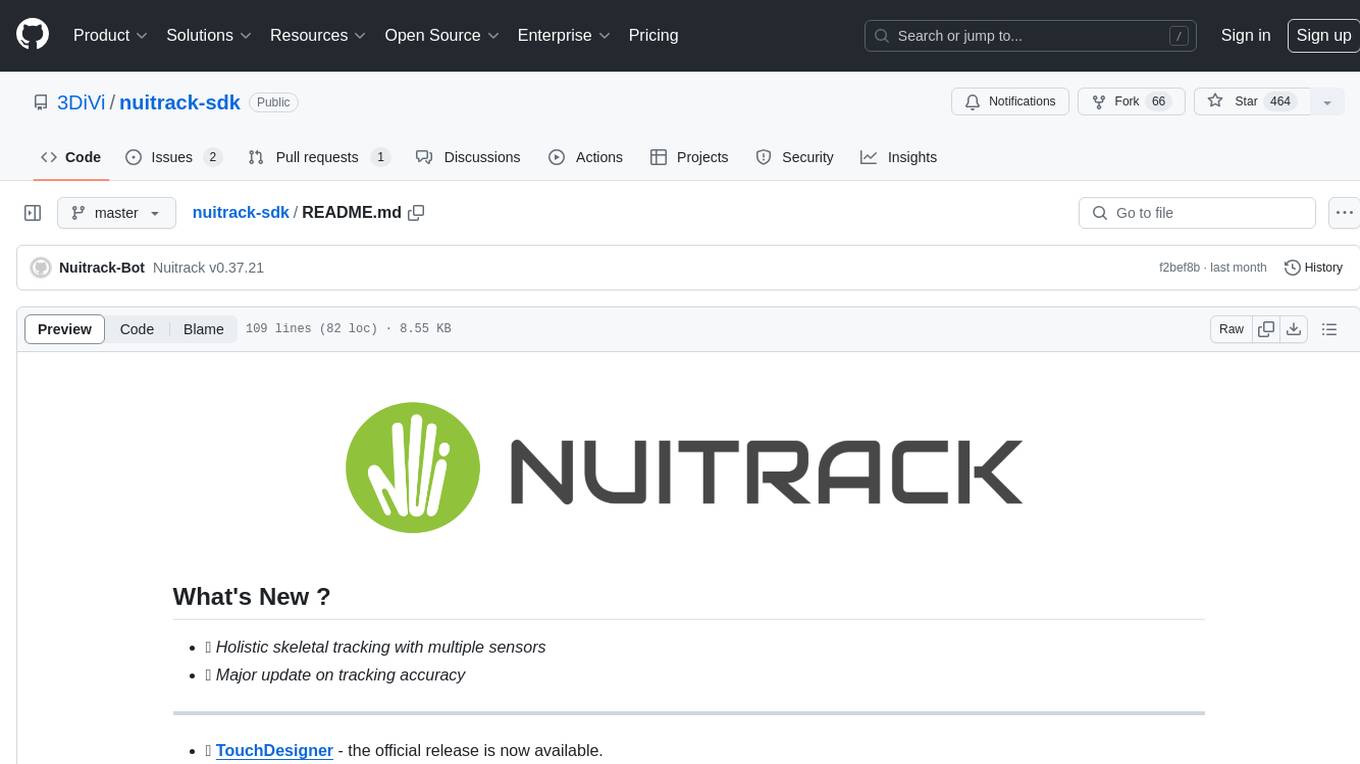
nuitrack-sdk
Nuitrack™ is an ultimate 3D body tracking solution developed by 3DiVi Inc. It enables body motion analytics applications for virtually any widespread depth sensors and hardware platforms, supporting a wide range of applications from real-time gesture recognition on embedded platforms to large-scale multisensor analytical systems. Nuitrack provides highly-sophisticated 3D skeletal tracking, basic facial analysis, hand tracking, and gesture recognition APIs for UI control. It offers two skeletal tracking engines: classical for embedded hardware and AI for complex poses, providing a human-centric spatial understanding tool for natural and intelligent user engagement.
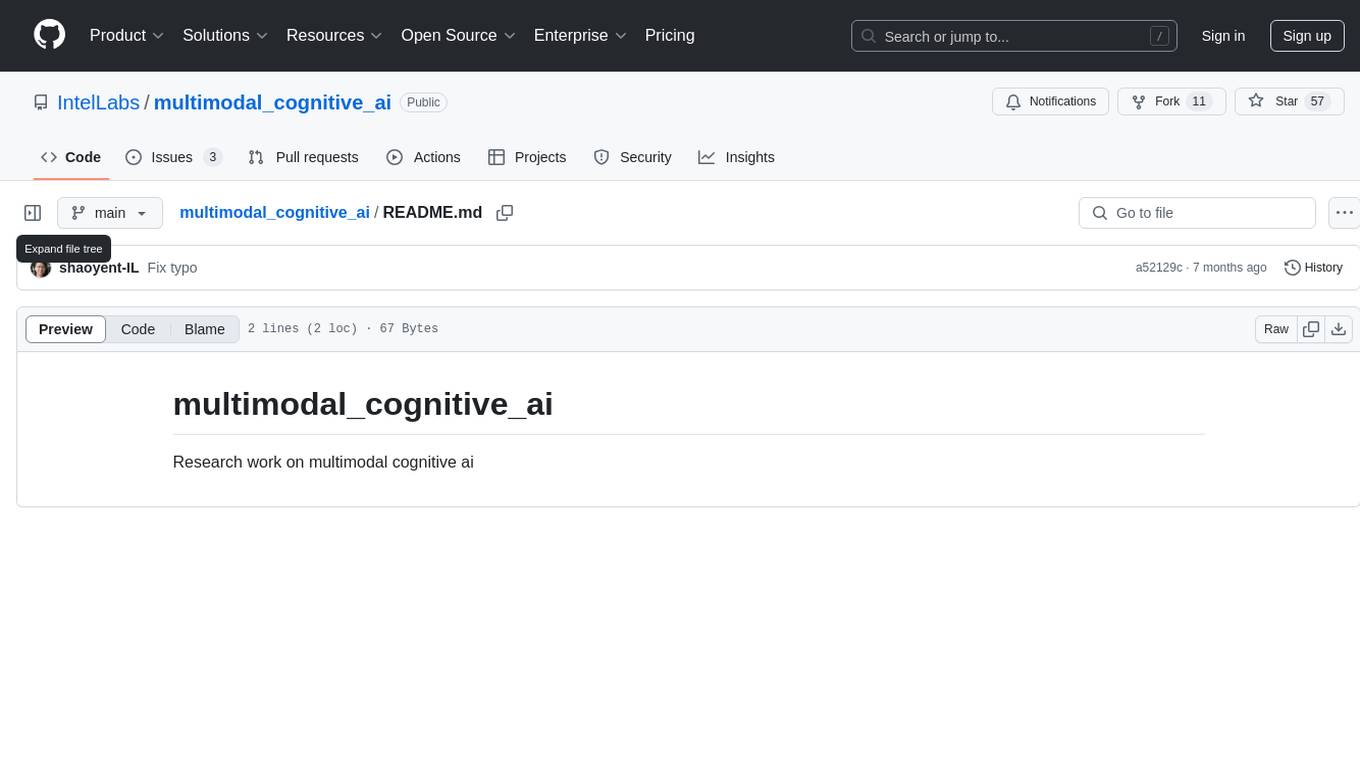
multimodal_cognitive_ai
The multimodal cognitive AI repository focuses on research work related to multimodal cognitive artificial intelligence. It explores the integration of multiple modes of data such as text, images, and audio to enhance AI systems' cognitive capabilities. The repository likely contains code, datasets, and research papers related to multimodal AI applications, including natural language processing, computer vision, and audio processing. Researchers and developers interested in advancing AI systems' understanding of multimodal data can find valuable resources and insights in this repository.

Friend
Friend is an open-source AI wearable device that records everything you say, gives you proactive feedback and advice. It has real-time AI audio processing capabilities, low-powered Bluetooth, open-source software, and a wearable design. The device is designed to be affordable and easy to use, with a total cost of less than $20. To get started, you can clone the repo, choose the version of the app you want to install, and follow the instructions for installing the firmware and assembling the device. Friend is still a prototype project and is provided "as is", without warranty of any kind. Use of the device should comply with all local laws and regulations concerning privacy and data protection.
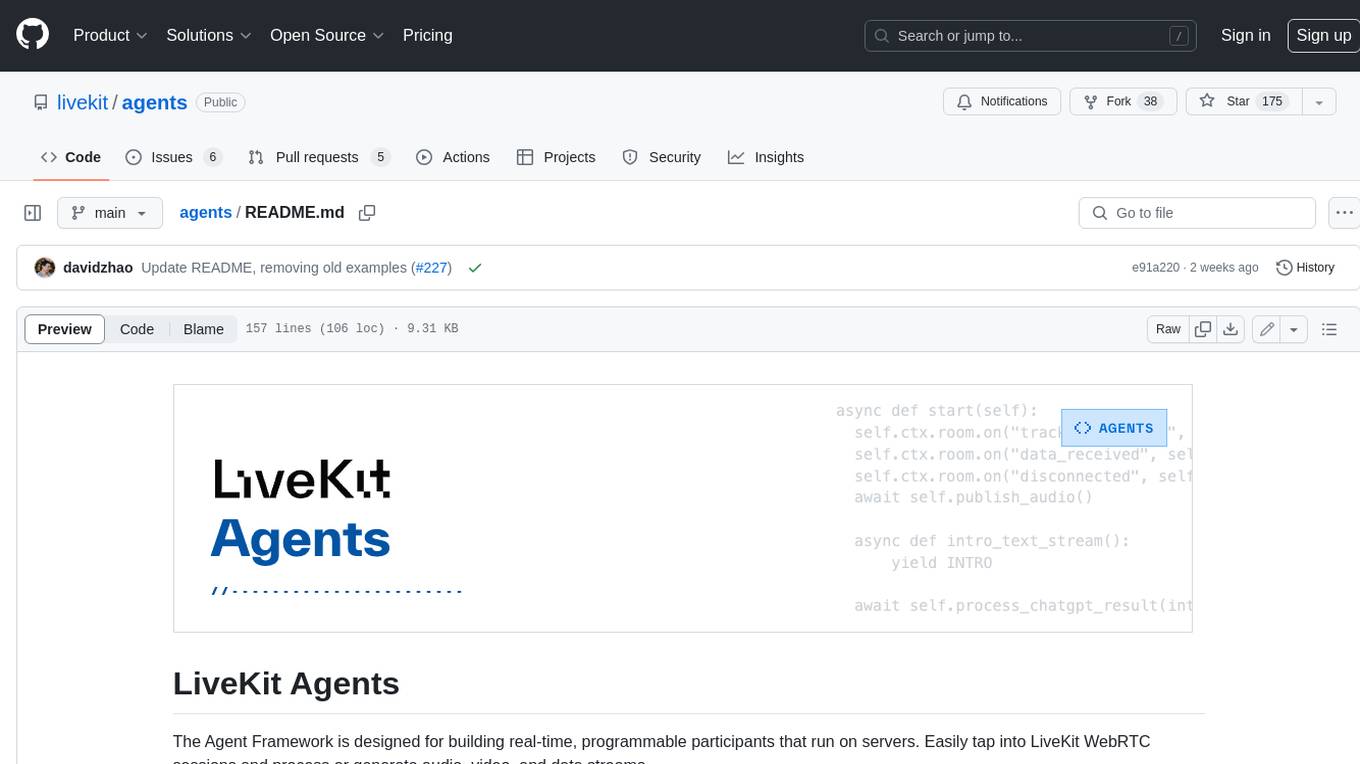
agents
The LiveKit Agent Framework is designed for building real-time, programmable participants that run on servers. Easily tap into LiveKit WebRTC sessions and process or generate audio, video, and data streams. The framework includes plugins for common workflows, such as voice activity detection and speech-to-text. Agents integrates seamlessly with LiveKit server, offloading job queuing and scheduling responsibilities to it. This eliminates the need for additional queuing infrastructure. Agent code developed on your local machine can scale to support thousands of concurrent sessions when deployed to a server in production.
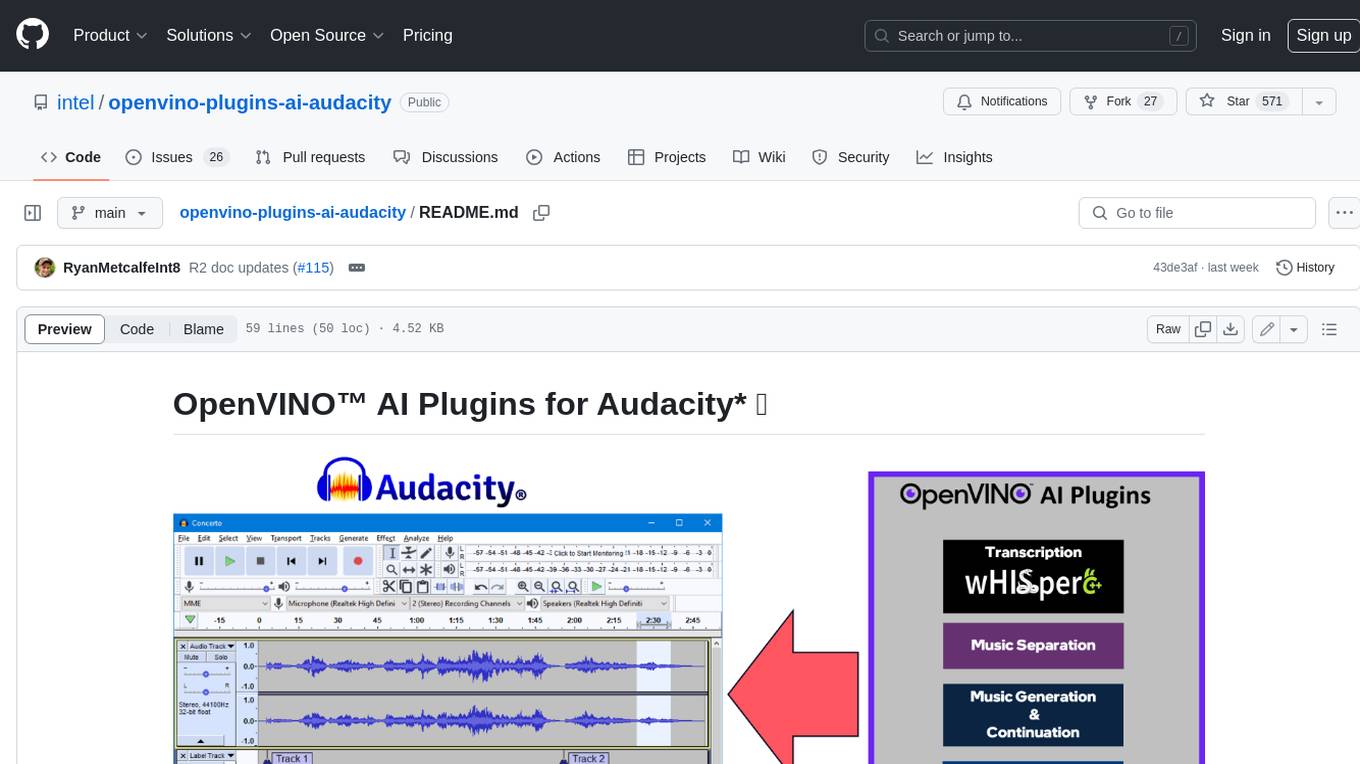
openvino-plugins-ai-audacity
OpenVINO™ AI Plugins for Audacity* are a set of AI-enabled effects, generators, and analyzers for Audacity®. These AI features run 100% locally on your PC -- no internet connection necessary! OpenVINO™ is used to run AI models on supported accelerators found on the user's system such as CPU, GPU, and NPU. * **Music Separation**: Separate a mono or stereo track into individual stems -- Drums, Bass, Vocals, & Other Instruments. * **Noise Suppression**: Removes background noise from an audio sample. * **Music Generation & Continuation**: Uses MusicGen LLM to generate snippets of music, or to generate a continuation of an existing snippet of music. * **Whisper Transcription**: Uses whisper.cpp to generate a label track containing the transcription or translation for a given selection of spoken audio or vocals.
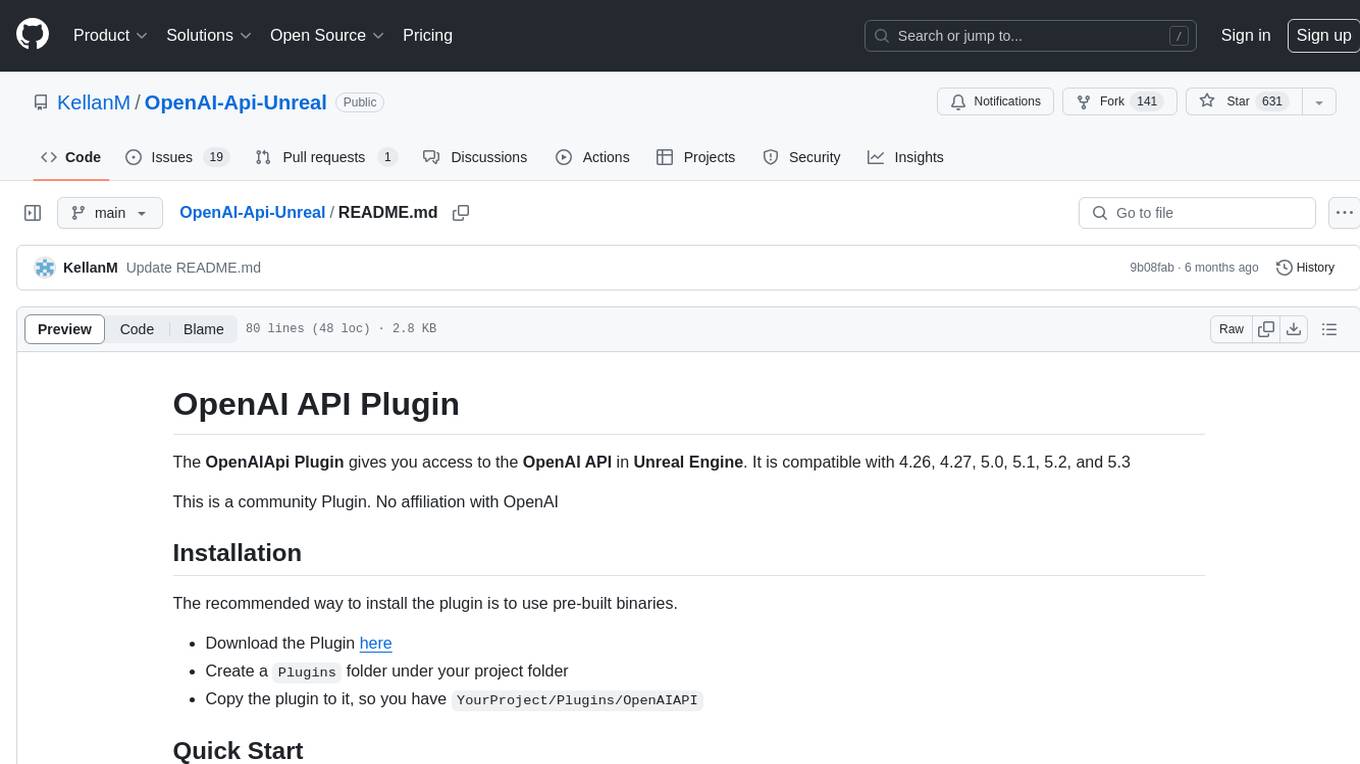
OpenAI-Api-Unreal
The OpenAIApi Plugin provides access to the OpenAI API in Unreal Engine, allowing users to generate images, transcribe speech, and power NPCs using advanced AI models. It offers blueprint nodes for making API calls, setting parameters, and accessing completion values. Users can authenticate using an API key directly or as an environment variable. The plugin supports various tasks such as generating images, transcribing speech, and interacting with NPCs through chat endpoints.
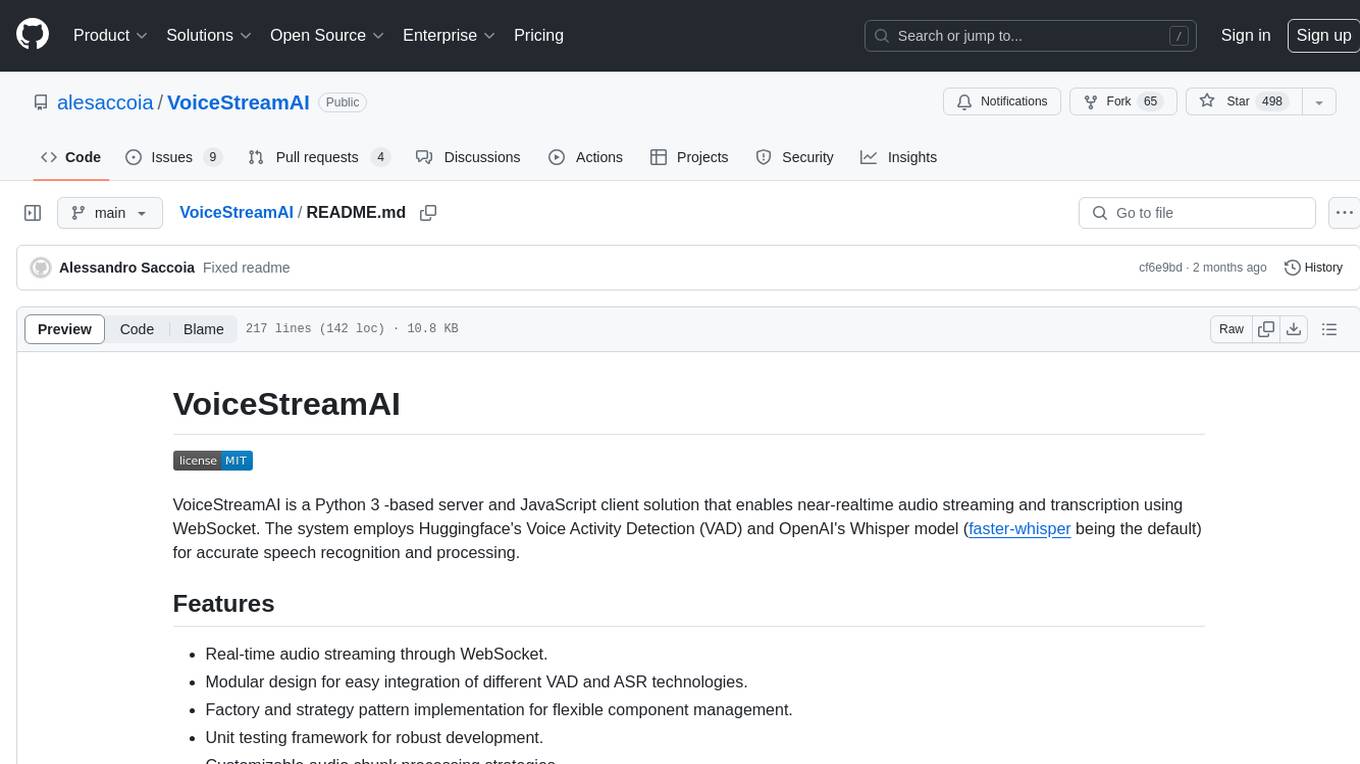
VoiceStreamAI
VoiceStreamAI is a Python 3-based server and JavaScript client solution for near-realtime audio streaming and transcription using WebSocket. It employs Huggingface's Voice Activity Detection (VAD) and OpenAI's Whisper model for accurate speech recognition. The system features real-time audio streaming, modular design for easy integration of VAD and ASR technologies, customizable audio chunk processing strategies, support for multilingual transcription, and secure sockets support. It uses a factory and strategy pattern implementation for flexible component management and provides a unit testing framework for robust development.
For similar jobs

sweep
Sweep is an AI junior developer that turns bugs and feature requests into code changes. It automatically handles developer experience improvements like adding type hints and improving test coverage.

teams-ai
The Teams AI Library is a software development kit (SDK) that helps developers create bots that can interact with Teams and Microsoft 365 applications. It is built on top of the Bot Framework SDK and simplifies the process of developing bots that interact with Teams' artificial intelligence capabilities. The SDK is available for JavaScript/TypeScript, .NET, and Python.

ai-guide
This guide is dedicated to Large Language Models (LLMs) that you can run on your home computer. It assumes your PC is a lower-end, non-gaming setup.

classifai
Supercharge WordPress Content Workflows and Engagement with Artificial Intelligence. Tap into leading cloud-based services like OpenAI, Microsoft Azure AI, Google Gemini and IBM Watson to augment your WordPress-powered websites. Publish content faster while improving SEO performance and increasing audience engagement. ClassifAI integrates Artificial Intelligence and Machine Learning technologies to lighten your workload and eliminate tedious tasks, giving you more time to create original content that matters.

chatbot-ui
Chatbot UI is an open-source AI chat app that allows users to create and deploy their own AI chatbots. It is easy to use and can be customized to fit any need. Chatbot UI is perfect for businesses, developers, and anyone who wants to create a chatbot.

BricksLLM
BricksLLM is a cloud native AI gateway written in Go. Currently, it provides native support for OpenAI, Anthropic, Azure OpenAI and vLLM. BricksLLM aims to provide enterprise level infrastructure that can power any LLM production use cases. Here are some use cases for BricksLLM: * Set LLM usage limits for users on different pricing tiers * Track LLM usage on a per user and per organization basis * Block or redact requests containing PIIs * Improve LLM reliability with failovers, retries and caching * Distribute API keys with rate limits and cost limits for internal development/production use cases * Distribute API keys with rate limits and cost limits for students

uAgents
uAgents is a Python library developed by Fetch.ai that allows for the creation of autonomous AI agents. These agents can perform various tasks on a schedule or take action on various events. uAgents are easy to create and manage, and they are connected to a fast-growing network of other uAgents. They are also secure, with cryptographically secured messages and wallets.

griptape
Griptape is a modular Python framework for building AI-powered applications that securely connect to your enterprise data and APIs. It offers developers the ability to maintain control and flexibility at every step. Griptape's core components include Structures (Agents, Pipelines, and Workflows), Tasks, Tools, Memory (Conversation Memory, Task Memory, and Meta Memory), Drivers (Prompt and Embedding Drivers, Vector Store Drivers, Image Generation Drivers, Image Query Drivers, SQL Drivers, Web Scraper Drivers, and Conversation Memory Drivers), Engines (Query Engines, Extraction Engines, Summary Engines, Image Generation Engines, and Image Query Engines), and additional components (Rulesets, Loaders, Artifacts, Chunkers, and Tokenizers). Griptape enables developers to create AI-powered applications with ease and efficiency.








